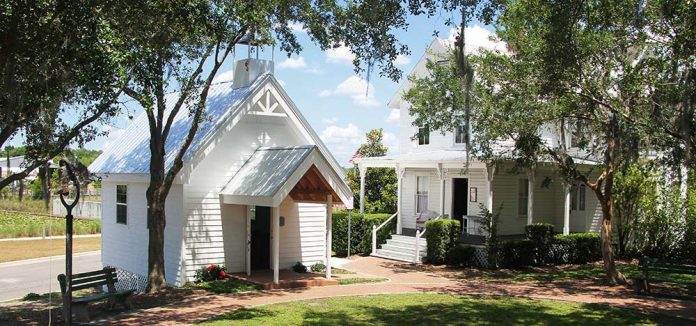Pictures and Article by Larry Oskin, South Lake Tablet
Located on the beautiful shores of Lake Minneola, the Clermont Historic Village has become a very special gem with plenty of exciting memories and a rich local history to share with every new generation. The newly built Grace Chapel is a replica of the original from the 1880s and will welcome small weddings, anniversaries and other celebrations of life by any group regardless of role or religious creed.
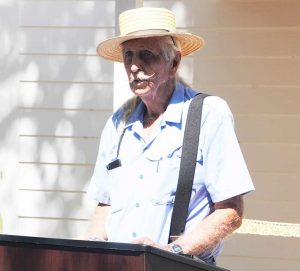
James Briggs, President of the Clermont Historical Society, led the dedication. He noted, “We would like to recognize several friends who helped put this new chapel together. First is Nick Jones, our architect who drew up our Clermont Historic Village plans for the chapel school house and outhouse. Our contractor Joe Collins, took on the many unique challenges of this structure. We took advantage of an experienced builder of church furniture to supply us with the eight 100-year-old pews. Several generous donors provided donations to cover the entire cost, so we did not need to have any fundraisers. We are fortunate to have had Alexandria Huggins who created our durable and beautiful stained-glass window. The Village Chapel is now available for weddings and renewal of vows.”

Micki Blackburn notes, “The Grace Chapel will be non-denominational and open to everyone regardless of religion. It will be a place to seek peace, grace, serenity and calmness for everyone. There are so many people to thank including Devon Cole, Jim Briggs, Larry Rescoe, previous Clermont Mayor Hal Turville and the current Clermont Mayor Tim Murry. James Briggs created the original conceptual drawings for the Grace Chapel. If it wasn’t for Hal Turville, we wouldn’t even have the Clermont /Historic Village. Today is a very happy day and a sad day. There are so many who shared the dream to build this chapel for Clermont, some who are unfortunately no longer with us.”
Clermont City Manager Brian Bulthuis shared, “This Clermont Historical Village is truly a remarkable place to preserve our history and memories. People can come here to see, feel and touch our local area history that was created by our ancestors. The idea behind the original chapel started over 130 years ago around 1889. We now have a beautiful replica to experience our amazing Clermont legacy, so we and our children will be able to remember our history for generations to come! The past matters. This Village is an asset to all of us in Clermont. It is my distinct honor to officially accept this chapel on behalf of the City of Clermont. We will take care of it to preserve our rich past history!”
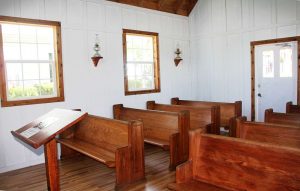 James Briggs created the original conceptual drawings for the Grace Chapel. Just like the old times around 1880 when settlers were first finding their way to settle in Clermont, The Village Chapel replica has plenty of charm, but it does not have amenities such as plumbing, air conditioning or electricity. To replicate the old Clermont Grace Chapel, interior walls called for a board and batten pattern with little more detailing on the end wall facing the entry. The main feature of The Village Chapel is the arched opening for a stained-glass window. Oak flooring completes the all-wood interior giving it some sense of the sacred. The entry porch faces the paved Memory Circle.
James Briggs created the original conceptual drawings for the Grace Chapel. Just like the old times around 1880 when settlers were first finding their way to settle in Clermont, The Village Chapel replica has plenty of charm, but it does not have amenities such as plumbing, air conditioning or electricity. To replicate the old Clermont Grace Chapel, interior walls called for a board and batten pattern with little more detailing on the end wall facing the entry. The main feature of The Village Chapel is the arched opening for a stained-glass window. Oak flooring completes the all-wood interior giving it some sense of the sacred. The entry porch faces the paved Memory Circle.
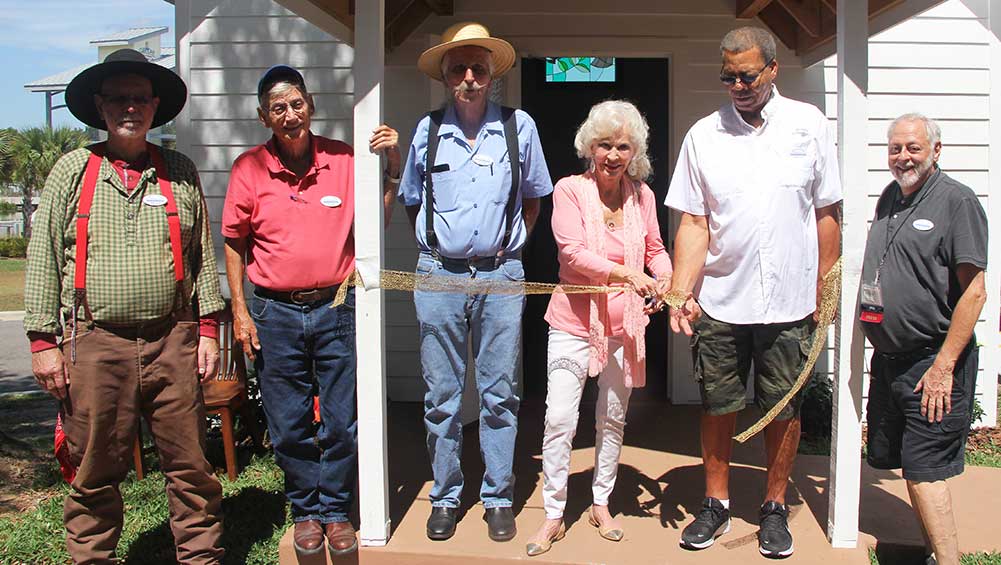
The Clermont Historical Society’s mission has always been to preserve and share the history of the pioneering families of South Lake County, especially the city of Clermont. The Clermont Historic Village helps you walk back through time from the late 1800s to the end of World War II. This property continues to uphold the dreams of the original members to have a Historic Village where people can learn about the local area lifestyle of times gone by.
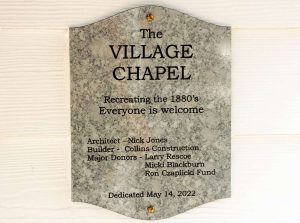 The Historic Village is a very unique collection of buildings from Clermont’s past, while each one is filled with fabulous antiquities and memorabilia. Plan to take a walk-through history at the Clermont Historic Village. Clermont’s Railroad Depot was built about 1925. The Quonset Hut is a World War II Museum. The Herring Hooks Schoolhouse is a replica of an old Clermont one-room school built in 1881. The Townsend House was built in 1895 by James and Sallie Townsend, the first black residents to settle in Clermont. The Kern House was built in 1885. The Cooper Memorial Library was built in 1914. There’s even a replica of an old outhouse. The Clermont Historic Village offers unique souvenirs and a Little Free Library book-sharing exchange. You can now host small special events at their Train Depot, the outdoor pavilion and The Village Chapel. The Clermont Historic Village is a unique partnership between the City of Clermont and the Clermont Historical Society. The City of Clermont owns and maintains the beautiful grounds and the buildings. The Historical Society owns all the furnishings and artifacts within the buildings. They are responsible for maintaining the interiors and for making the Village available to the public.
The Historic Village is a very unique collection of buildings from Clermont’s past, while each one is filled with fabulous antiquities and memorabilia. Plan to take a walk-through history at the Clermont Historic Village. Clermont’s Railroad Depot was built about 1925. The Quonset Hut is a World War II Museum. The Herring Hooks Schoolhouse is a replica of an old Clermont one-room school built in 1881. The Townsend House was built in 1895 by James and Sallie Townsend, the first black residents to settle in Clermont. The Kern House was built in 1885. The Cooper Memorial Library was built in 1914. There’s even a replica of an old outhouse. The Clermont Historic Village offers unique souvenirs and a Little Free Library book-sharing exchange. You can now host small special events at their Train Depot, the outdoor pavilion and The Village Chapel. The Clermont Historic Village is a unique partnership between the City of Clermont and the Clermont Historical Society. The City of Clermont owns and maintains the beautiful grounds and the buildings. The Historical Society owns all the furnishings and artifacts within the buildings. They are responsible for maintaining the interiors and for making the Village available to the public.
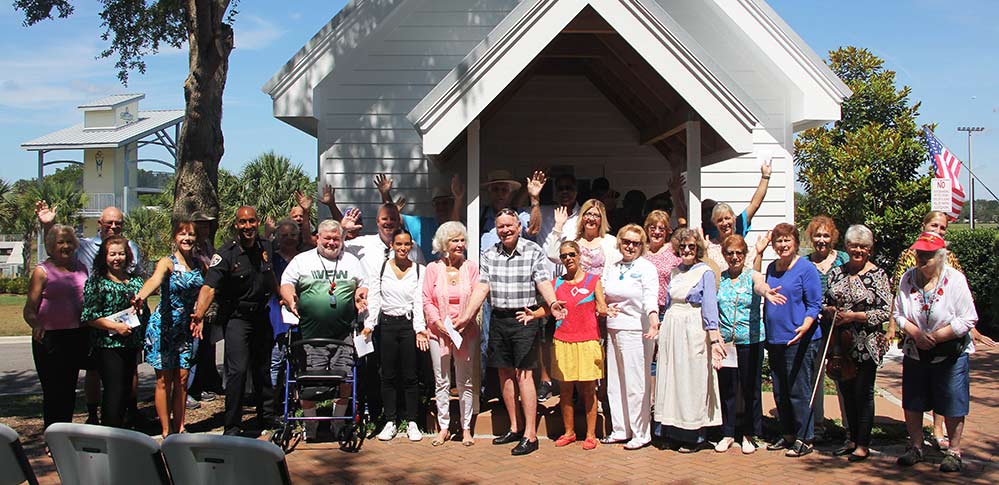
The Clermont Historic Village has been developed and maintained by the City of Clermont and the Clermont Historical Society. Founded in 1998 as the South Lake County Historical Society, the Society is a 501-C3 organization. The Clermont Historic Village is located at 490 West Avenue, Clermont, FL 34711 next to Victory Pointe near Downtown Clermont. The Village is open every Saturday and Sunday from 1 to 4 PM, by arranging group and individual tours during non-scheduled hours upon request and by hosting events highlighting the history of the Clermont community.
Admission during regularly scheduled hours is free. A donation of only $5 per person over 12 is requested. For those interested; membership dues are a tax-deductible donation of only $25 per year. You can also become a Lifetime Member for $500. For more information, email the Village Manager at: SLHistoricalSociety@GMail.com, call 352-242-7734 or visit www.ClermontHistoricVillage.org. Follow their updates on Facebook at: https://www.facebook.com/ClermontVillage..



